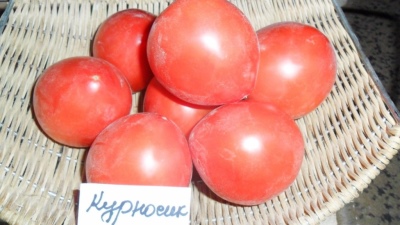
- Authors: Gavrish S.F., Kapustina R.N., Gladkov D.S., Volkov A.A., Semenova A.N., Artemyeva G.M., Filimonova Yu.A., Redichkina T.A.
- Year of approval: 2011
- Category: grade
- Growth type: determinant
- Appointment: fresh consumption
- Ripening period: early
- Ripening time, days: 110-115
- Growing conditions: for film greenhouses
- Bush size: undersized
- Bush height, cm: 50
It is hardly possible to call Kurnosik a completely new variant of tomato culture. However, there are not too many gardeners who know its features, since it is rather difficult not to get lost in the ocean of varieties that surrounds it now. And that is why objective information is urgently needed.
Breeding history
The Kurnosik variety was allowed to grow in private gardens in 2011. Before that, of course, a lot of breeding work had been done. Breeders participated in the project:
- Gavrish;
- Redichkina;
- Gladkov;
- Semenova;
- Kapustina;
- Artemieva;
- Volkov;
- Filimonov.
Description of the variety
Kurnosika plants are characterized by a determinant type of development. Basically, this crop is declared as suitable for a film greenhouse. Its bushes rise to a maximum height of 50 cm. Light green moderately large foliage develops on the branches.
The main qualities of the fruit
Kurnosika berries are light green in color. But it only lasts until they ripen. When fully ripe, the crop will have the usual red color. The usual weight of tomatoes is 0.15-0.2 kg. In shape, they look like a stereotyped heart.
Ribs in the fruits of Kurnosik are present, but they are weakly expressed. Up to 4 berries are formed on the brush. Inflorescences of a simple type are characteristic.
Taste characteristics
The pulp of the fruit is of medium density. In the descriptions, its invariably high sugar content is noted. The tasters also emphasize the juiciness of these berries. Mostly harvested tomatoes are used fresh.
Ripening and fruiting
Tomato Kurnosik is considered an early tomato. Between the formation of green seedlings and the full readiness of the sweet red crop, an average of 110-115 days pass. However, in specific years, meteorological surprises can have a negative effect.
Yield
Up to 6.5 kg of berries can be harvested per 1 m2. Of course, this result is achieved only with the use of impeccable agricultural technology.
The timing of planting seedlings and planting in the ground
You need to prepare containers with seedlings (plant seeds in them) already at the end of March or in the first decade of April. Subject to the normal development of plants, they can usually be transplanted into open ground as early as May. But the final decision is always made taking into account the real state of the seedlings. You also need to pay attention to the degree of heating of the soil and the actual weather.

Growing tomato seedlings is an extremely important process, because it largely depends on whether the gardener will be able to harvest at all. All aspects must be taken into account, from seedbed preparation to planting in the ground.
Landing scheme
It is recommended to arrange the bushes in the garden according to the rule of 400x500 mm. Inventing other schemes is less productive than relying on a system that has been proven by suppliers of planting stock.

Growing and care
For the cultivation of tomato Kurnosik, it is imperative to use only soil saturated with useful substances. Seeds must be treated with a solution of potassium permanganate. A pick is made after the appearance of the first leaves. Watering is carried out once every 5-7 days. The use of mineral fertilizers is highly recommended.
A prerequisite for success is loosening the soil. At an early stage of culture development, special preparations are used to protect against pests and infections. Later, only safe natural remedies should be used. There is no need for pinning. Getting the earliest harvest is possible only when using greenhouses that protect against return frost.




A plant needs different micronutrients at each stage of growth. All fertilizers can be divided into two groups: mineral and organic. Folk remedies are often used: iodine, yeast, bird droppings, eggshells.
It is important to observe the rate and period of feeding. This also applies to folk remedies and organic fertilizers.


Growing regions
Kurnosik bushes will delight you with their fruits:
- Ural;
- Moscow region;
- Far Eastern;
- West Siberian;
- North Caucasian;
- Volga region;
- black earth;
- summer residents living in the north and northwest of the European part of Russia.
Review overview
Those gardeners who have been planting plants of this variety for several years are completely satisfied with the result. The size and weight of the fruits, even if they do not reach the declared upper bar, are quite decent. There will be no problems with the amount of the harvest. It turns out to be relatively easy to care for the plantings. In terms of gastronomy, the harvest is no worse than from the point of view of a gardener.

























































































